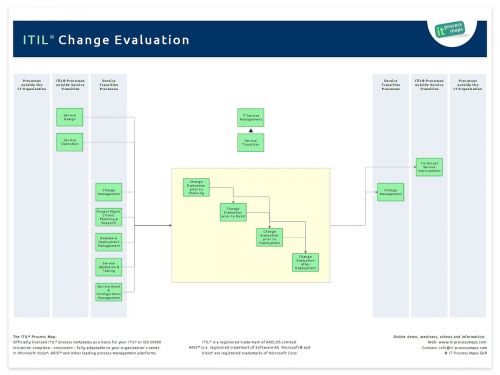ITIL Change Evaluation
Objective: ITIL Change Evaluation aims to assess major Changes, like the introduction of a new service or a substantial change to an existing service, before those Changes are allowed to proceed to the next phase in their lifecycle.
Part of: Service Transition
Process Owner: Change Manager
Process Description
ITIL 2011 has introduced the Change Evaluation process, including a clarification in the ITIL® books that the purpose of this process is the evaluation of Major Changes.
Change Evaluation is called upon by the Change Management process at various points in a Change's lifecycle to perform a Change assessment.
The results of a formal Change evaluation are documented in a Change Evaluation Report, which is thus the main output of the process.
The process overview of ITIL Change Evaluation shows the key information flows (see fig. 1).
The latest edition of ITIL 4 does not include a Change Evaluation process. The key change evaluation activities are described in the service management practice of "Change Enablement".
Sub-Processes
These are the ITIL Change Evaluation sub-processes and their process objectives:
Change Evaluation prior to Planning
- Process Objective: To assess a proposed major Change before authorizing the Change planning phase.
Change Evaluation prior to Build
- Process Objective: To assess a proposed major Change before authorizing the Change build phase.
Change Evaluation prior to Deployment
- Process Objective: To assess a proposed major Change before authorizing the Change deployment phase.
Change Evaluation after Deployment
- Process Objective: To assess a major Change after it has been implemented, to verify if the Change has met its objectives and to identify any lessons to be learned.
Definitions
The following ITIL terms and acronyms (information objects) are used in ITIL Change Evaluation to represent process outputs and inputs:
Change Evaluation Report
- Certain types of major Changes, like the introduction of a new service or a substantial change to an existing service, require formal Change evaluations before being authorized. The results of a formal Change evaluation are documented in a Change Evaluation Report. Change evaluations may be used at different points in a Change's lifecycle, for example before authorizing the Change/Release build or during the Post Implementation Review.
Roles | Responsibilities
Change Manager - Process Owner
- The Change Manager controls the lifecycle of all Changes. His primary objective is to enable beneficial Changes to be made, with minimum disruption to IT services. For important Changes, the Change Manager will refer the authorization of Changes to the Change Advisory Board (CAB).
| ITIL Role / Sub-Process | Change Manager | Other roles involved |
|---|---|---|
| Change Evaluation prior to Planning | A[1] | R[2][3] |
| Change Evaluation prior to Build | A | R[3] |
| Change Evaluation prior to Deployment | A | R[3] |
| Change Evaluation after Deployment | A | R[3] |
Remarks
[1] A: Accountable according to the RACI Model: Those who are ultimately accountable for the correct and thorough completion of the Change Evaluation process.
[2] R: Responsible according to the RACI Model: Those who do the work to achieve a task within Change Evaluation.
[3] In cooperation, as appropriate: Applications Analyst, Technical Analyst, Configuration Manager, Project Manager, Risk Manager and others. Role descriptions...
Notes
By: Stefan Kempter ![]() , IT Process Maps.
, IT Process Maps.
Process Description › Sub-Processes › Definitions › Roles






